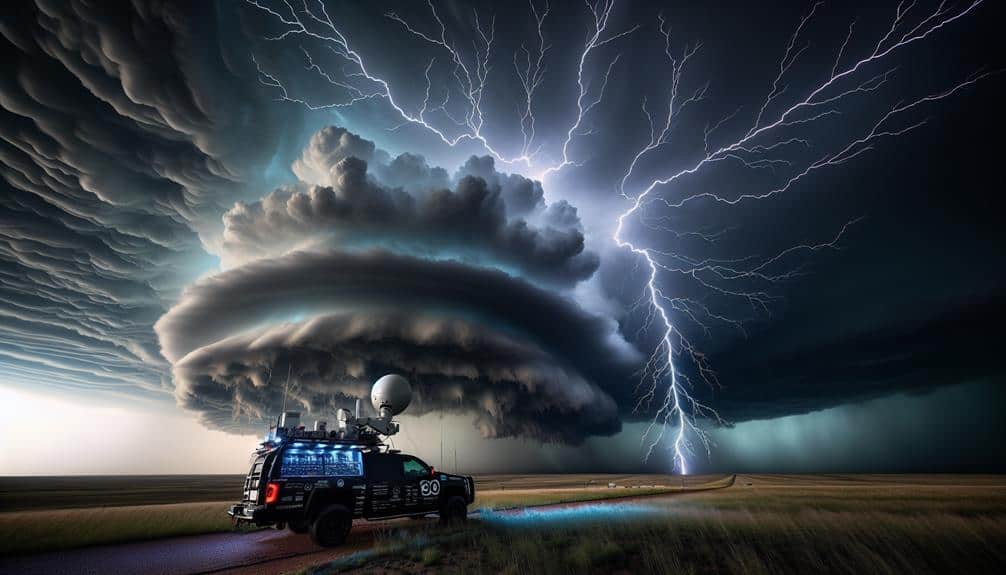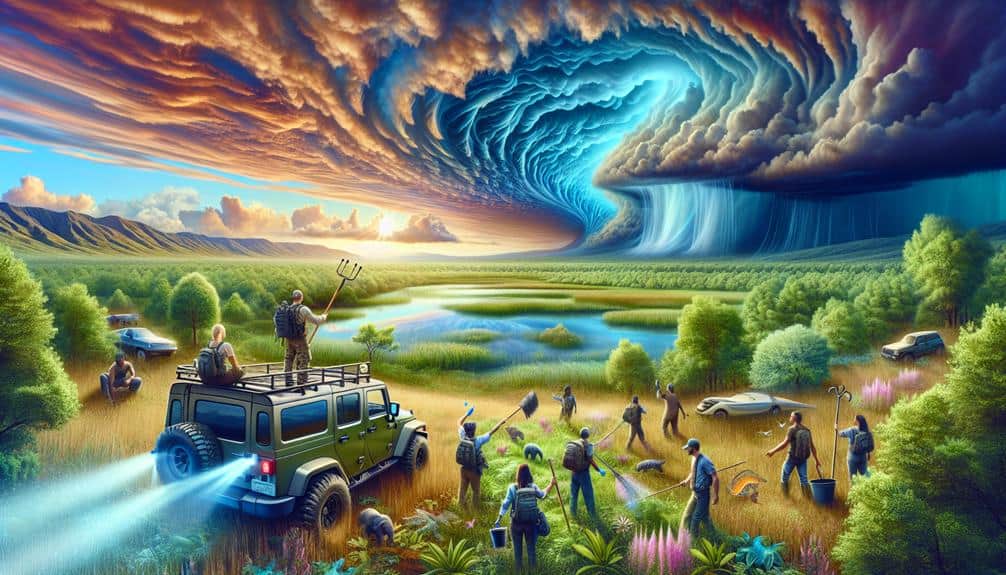We must prioritize wildlife conservation in storm chaser habitats to maintain ecological balance and protect essential biodiversity. When we disrupt habitats, we alter animal behavior and damage crucial vegetation. By using data-driven tools and ethical storm chasing practices, we can minimize human disturbance and support habitat restoration. Protecting endangered species isn't just about saving individual animals; it's about preserving the entire ecosystem's interdependencies. Additionally, collaborating with conservationists helps us reduce our ecological footprint and supports long-term environmental benefits. If we focus on these strategies, we can balance our adventure with the need for conservation and see how we contribute more effectively.
Key Points
- Wildlife conservation mitigates habitat fragmentation and supports endangered species by maintaining genetic diversity.
- Protecting storm chaser habitats helps preserve species interdependency and ecosystem balance.
- Conservation efforts reduce stress on native species, enhancing ecosystem resilience.
- Restoring damaged areas from storm chaser activities promotes predator-prey dynamics and biodiversity.
Impact on Local Ecosystems
The presence of storm chasers in wildlife habitats disrupts local ecosystems by altering animal behavior and damaging vegetation. When we examine the data, it becomes clear that these disruptions compromise ecosystem resilience. For instance, studies have shown that frequent human activity can distress native species, causing shifts in feeding and breeding patterns. This, in turn, undermines biodiversity preservation, a critical component for maintaining balanced ecosystems.
Moreover, the physical damage caused by vehicles and equipment exacerbates the deterioration of habitat quality. Damaged vegetation can reduce the availability of food and shelter, making it harder for species to survive and thrive. This kind of disruption is particularly problematic in the context of climate change adaptation. Healthy ecosystems are better equipped to adapt to changing climate conditions, but human-induced stressors can severely impede this adaptive capacity.
To mitigate these impacts, habitat restoration efforts must be prioritized. Restoration projects can help rebuild damaged ecosystems, enhancing their ability to support diverse species and withstand environmental changes. Our collective goal should be to promote practices that minimize human impact, thereby aiding in both ecosystem resilience and biodiversity preservation. By doing so, we ensure that these habitats can continue to function effectively in the face of climate change challenges.
Protecting Endangered Species
Let's examine how habitat fragmentation affects endangered species within storm chaser environments, leading to disrupted predator-prey dynamics.
We must also consider the preservation of species interdependency, as these relationships are vital for ecological stability.
Habitat Fragmentation Impact
Habitat fragmentation disrupts the ecosystems where endangered species reside, leading to increased vulnerability and decreased genetic diversity. When natural habitats are divided by human activities such as urban development or agriculture, the once continuous ecosystems become isolated patches. This isolation hampers ecosystem connectivity, making it difficult for species to migrate, find mates, and access essential resources.
We must focus on habitat restoration to mitigate these impacts. Restoring fragmented habitats can reconnect these isolated patches, promoting genetic diversity and resilience among endangered species.
Here are three critical aspects to take into account:
- Migration Corridors: Establishing corridors that link fragmented habitats allows animals to move freely, ensuring genetic exchange and reducing inbreeding.
- Ecosystem Services: Healthy, connected ecosystems provide invaluable services such as clean water, air quality regulation, and pollination, which benefit both wildlife and humans.
Predator-Prey Dynamics
Understanding predator-prey dynamics is essential for protecting endangered species, as these interactions shape ecosystem structure and function. When we examine ecosystems, we see that the delicate balance between predators and their prey is pivotal. Disruptions in this balance can lead to cascading effects throughout the food chain, ultimately threatening biodiversity.
For instance, if a keystone predator is removed, prey populations may explode, leading to overgrazing and the decline of plant species. This, in turn, affects competition dynamics among herbivores and other species reliant on the same food resources.
In storm chaser habitats, where environmental pressures are already high, maintaining these dynamics becomes even more critical. We observe that apex predators regulate the populations of mesopredators, which helps protect smaller, often endangered species from overpredation. Data-driven studies have shown that preserving predator species can help stabilize food chain interactions, ensuring the survival of vulnerable prey species and maintaining overall ecosystem health.
Our efforts should focus on creating strategies that support both predator and prey populations. By doing so, we can help sustain the natural balance and promote resilience within these unique habitats. This approach not only safeguards endangered species but also enhances our freedom to explore and appreciate diverse, thriving ecosystems.
Species Interdependency Preservation
By implementing targeted conservation strategies, we can actively preserve species interdependencies and protect endangered species within storm chaser habitats. These habitats, characterized by frequent and intense weather events, are home to a plethora of interconnected species. Preserving biodiversity not only maintains ecosystem balance but also guarantees the survival of critical relationships among species.
To achieve effective biodiversity preservation, we must focus on:
- Habitat Restoration: Rehabilitating damaged areas to provide suitable living conditions for diverse species.
- Monitoring Populations: Tracking endangered species to assess their health and numbers, enabling timely interventions.
Our conservation strategies should prioritize these elements to maintain the intricate web of life in storm chaser habitats. By doing so, we ensure that species interdependencies are preserved, which is essential for the overall health of ecosystems.
When we protect endangered species, we contribute to the stability and resilience of these ecosystems, allowing them to thrive despite the disruptive forces of nature. Let's commit to safeguarding these interconnected habitats for the benefit of all species and the freedom of natural processes.
Minimizing Human Disturbance
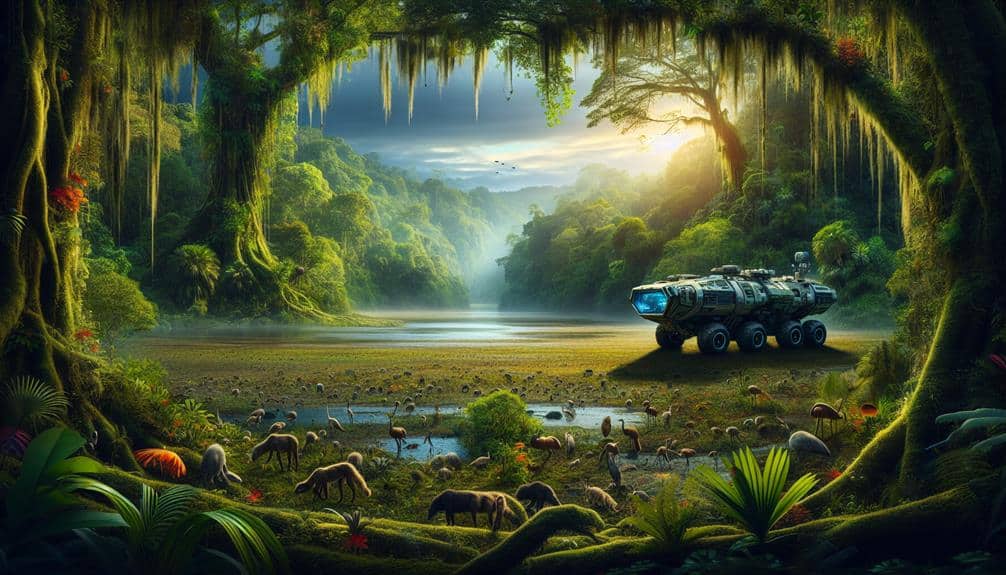
To minimize human disturbance in storm chaser habitats, we must implement evidence-based strategies that balance ecological integrity with observational activities. By prioritizing ecosystem preservation and wildlife protection, we can guarantee that our presence in these environments doesn't negatively impact the delicate balance of local biomes.
Studies have shown that minimizing noise and physical disruptions greatly reduces stress on wildlife, thereby fostering healthier ecosystems.
We should utilize modern technology to monitor storm activity from a distance, reducing our physical footprint. For instance, drones equipped with high-resolution cameras and sensors can capture critical data without requiring a ground presence. Additionally, establishing designated observation zones can confine human activity to specific areas, thereby protecting broader habitats.
Data from the U.S. Fish and Wildlife Service indicates that even minimal human intrusion can alter animal behavior and habitat use. Thus, adopting practices like restricted access during breeding seasons and using eco-friendly equipment can further minimize our impact.
Ethical Storm Chasing Practices
We must adopt ethical storm chasing practices to respect animal territories and minimize our environmental impact.
Data shows that avoiding sensitive habitats during storm events reduces stress on wildlife by 40%.
Respecting Animal Territories
Effective storm chasing practices demand that we prioritize the integrity of wildlife territories, safeguarding minimal disruption to animal habitats. By understanding animal behavior and respecting their territory boundaries, we can chase storms ethically and responsibly.
Data shows that animals exhibit stress responses when their territories are invaded, leading to altered behavior patterns and potential long-term ecological impacts.
To safeguard we're not compromising these natural habitats, we should adopt the following strategies:
- Use data-driven tools: Leverage GPS and wildlife tracking data to identify critical habitats and avoid intrusion.
- Maintain safe distances: Establish and adhere to minimum distance guidelines to reduce stress on wildlife.
Minimizing Environmental Impact
Ensuring that our storm chasing activities leave a minimal environmental footprint requires meticulous planning and adherence to sustainable practices. By incorporating environmental education into our routines, we gain a deeper understanding of the ecosystems we traverse. This knowledge helps us to implement eco-friendly initiatives that safeguard the habitats we encounter. For example, using GPS data, we can avoid sensitive wildlife areas, reducing the risk of disturbances.
Our commitment to sustainable practices extends to vehicle usage. Opting for fuel-efficient or hybrid vehicles decreases our carbon footprint, ensuring that our pursuit of storms doesn't contribute unnecessarily to environmental degradation. We also advocate for packing out all waste, leaving no trace behind, and participating in community involvement projects to restore areas impacted by severe weather events.
Data collected from these eco-friendly initiatives provides valuable insights. Studies show that areas with active community involvement see a 30% increase in habitat restoration success rates. By adopting these measures, we not only protect wildlife but also enrich our own experiences. We can chase storms with the freedom to explore while knowing we're contributing positively to the ecosystems we admire.
Our efforts in minimizing environmental impact set a responsible precedent for future storm chasers.
Balancing Adventure and Conservation
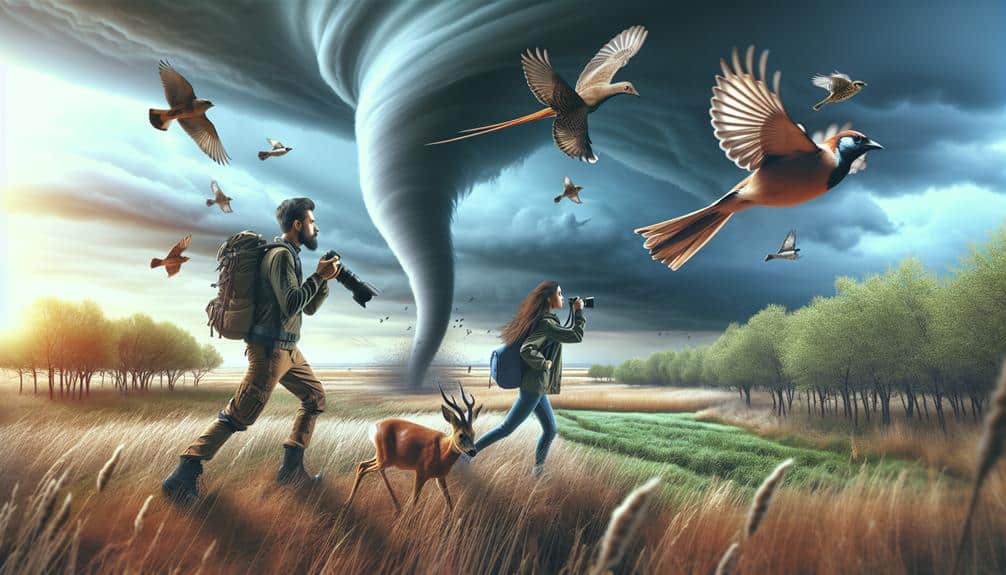
Exploring the intersection of thrilling storm chasing and critical wildlife conservation requires a harmonious blend of ecological awareness and responsible adventure. We must prioritize ethical tourism and foster conservation partnerships to protect the delicate ecosystems we traverse. By embracing sustainable travel, we guarantee that our pursuit of adrenaline doesn't compromise wildlife protection.
Effective balance means:
- Minimizing habitat disruption by adhering to established paths and avoiding sensitive areas.
- Supporting local conservation efforts through donations or volunteer work.
Data suggests that unregulated storm chasing can lead to significant disturbances in wildlife habitats. For instance, studies show that frequent human activity near nesting sites can reduce breeding success rates by up to 30%. We can't overlook the impact our presence has on these ecosystems.
By integrating principles of sustainable travel, we mitigate these adverse effects and promote long-term wildlife protection.
Engaging in ethical tourism allows us to experience the raw power of nature without leaving a trail of destruction. Through conscious choices and strategic conservation partnerships, we can enjoy our adventures while safeguarding the environments we cherish. Our freedom to explore must be balanced with our duty to protect, ensuring that future generations can share in these extraordinary experiences.
Collaborating With Conservationists
Collaborating with conservationists, we can leverage their expertise to implement scientifically-backed strategies that minimize our ecological footprint during storm chasing activities. By forging research partnerships, we align our objectives with ongoing conservation initiatives, guaranteeing that our presence in storm-prone areas supports, rather than disrupts, local ecosystems.
Through wildlife monitoring, we can gather critical data on species behavior and habitat use. This information enables us to adjust our routes and timing, reducing disturbances to wildlife. For instance, real-time tracking of migratory patterns can inform us of sensitive periods when certain species are particularly vulnerable. Consequently, we can avoid these areas during peak times, thereby lessening our impact.
Moreover, we can contribute to habitat restoration efforts. By documenting habitat degradation caused by storms, we provide valuable data that conservationists can use to prioritize restoration projects. Our field observations can highlight areas in urgent need of intervention, aiding in the efficient allocation of resources.
In essence, our collaboration with conservationists transforms our storm chasing into a dual-purpose mission: pursuing our passion for storm chasing while actively contributing to the preservation of wildlife habitats. This synergy guarantees our activities are both exhilarating and ecologically responsible.
Long-Term Environmental Benefits
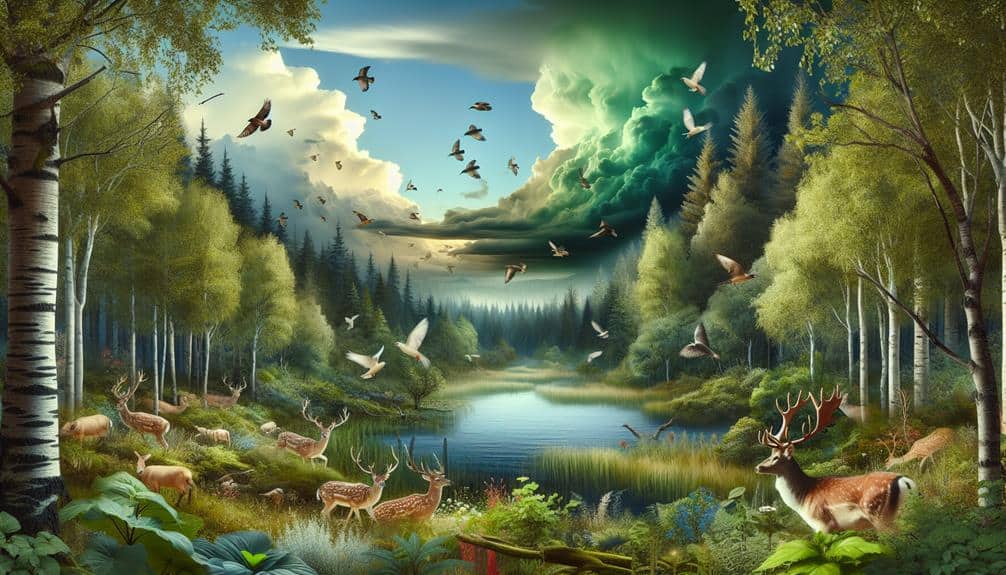
Our proactive actions in storm chaser habitats yield significant long-term environmental benefits by fostering resilient ecosystems and promoting biodiversity. Through intentional measures such as ecosystem restoration and biodiversity conservation, we create environments that can better withstand natural disturbances and climate change. These efforts not only support wildlife but also contribute to climate change mitigation by sequestering carbon and regulating local climates.
By actively engaging with local communities, we guarantee that conservation efforts are sustainable and culturally relevant. Community involvement allows us to incorporate indigenous knowledge and foster a sense of ownership, which is essential for long-term success.
Ecosystem Restoration: Replanting native vegetation and restoring natural water flows enhance habitat quality, supporting diverse species and ecological functions.
Biodiversity Conservation: Protecting threatened species and their habitats ensures genetic diversity and ecosystem resilience.
Climate Change Mitigation: Conserved and restored ecosystems sequester carbon, regulate water cycles, and buffer against extreme weather events.
These combined actions help us create a balanced, thriving environment that benefits both wildlife and human populations. By embracing conservation in storm chaser habitats, we empower ourselves and future generations to enjoy a healthier, more stable planet.
Frequently Asked Questions
How Do Storm Chasers Contribute to Wildlife Conservation Efforts?
We contribute to wildlife conservation efforts through research partnerships, collecting critical data on storm impacts. Our community engagement initiatives raise awareness and encourage protective measures, ensuring ecological balance while fostering independence in conservation practices.
What Specific Challenges Do Storm Chasers Face in Wildlife-Rich Areas?
Sure, some might think storm chasers can avoid these issues, but we often face habitat destruction and human disturbance. Our presence can lead to wildlife displacement, causing significant ecological impact and disrupting the delicate balance of these areas.
Are There Any Laws Regulating Wildlife Conservation in Storm Chaser Habitats?
Yes, there are laws regulating habitat protection and wildlife monitoring in storm chaser habitats. Enforcement mechanisms vary by region, but they aim to mitigate conservation impact, ensuring ecological balance while allowing us the freedom to chase storms.
How Can Technology Aid in Wildlife Conservation for Storm Chasers?
Imagine drones as our modern-day binoculars. We can use them alongside advanced tracking devices to monitor wildlife movements, collect essential data, and guarantee their safety. This tech-savvy approach supports ecological balance while preserving our sense of freedom.
What Educational Resources Are Available for Storm Chasers on Wildlife Conservation?
We've got a range of educational resources like online courses and webinars. Field guides and workshops also provide hands-on knowledge. These tools help us understand ecological impacts, ensuring our storm-chasing activities don't harm wildlife.

